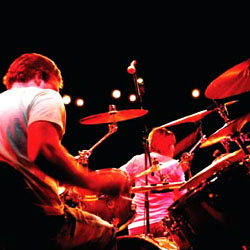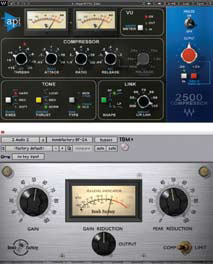
Time Flies
Aligning dual kick drum mics has been around since the early ProTools days, a technique that slightly delays the mic inside the drum to the outside mic.
At low frequencies, the distance between the two mics is relatively small compared to the wavelength, but at higher frequencies, the attack, or “click” can be obscured by the slight difference in arrival time – enough to muddy the combined sound above 1,000 Hz with comb-filtering.
Adding a millisecond of delay to the inside mic can clean up the highs and restore the click.
Also, matching the distance from the center of the snare drum to each overhead mic by using the length of two drumsticks end-to-end is a longstanding drum roadie trick that ensures the snare – the drum kit’s loudest sound – arrives in both overheads at the same time.
As with the kick mics, digital consoles allow the engineer to delay the snare – and even the toms – to their arrival in the overheads. The “two drumstick” measurement then can insure that delays set for snare and toms are correct.

In the Library
Digital consoles can store preset files in EQ libraries. While you may actually bring a digital console with you in a truck or bus trailer, the true value is in their files – not just past show settings – but their libraries, a collection of presets that can be called up with a push of a button.
Since most engineers repeatedly use the same model of drum mic the same way, saving EQ presets allows engineers to quickly pre-adjust their entire drum kit EQ by loading a previously tweaked preset for each drum mic into the right channel.
Presets like “KICK52” or “HAT451” have meaningful names that describe their use, allowing them to be correctly identified and quickly applied.
Library presets aren’t meant to replace actually listening to drums during sound check. Purists actually prefer starting with flat, “zero’ed” channel EQ and adjusting from there.
Even for that, however, a blank preset can help by having each band’s “Q” and frequency at a good starting place, even if the gains are near 0 dB. Since a Midas XL3 (and XL42) is my favorite EQ, I like to begin with my frequencies at 100, 600, 2,000 and 6,000 Hz, and my Q at 2.
Similarly, libraries for onboard dynamics can be saved with the same kind of file names as their companion EQ files.
In fact, the exact same naming structure can be used, so “RACK57” could also be the name for a gate or compressor library preset.
Reverb plays a vital role in drum sounds and most digital consoles include several algorithms, each with a variety of factory presets, offering studio-class sounds and making outboard effects a thing of the past.
As with EQ and dynamics, effect libraries are a great way to tweak individual presets for specific uses, whether it’s a pre-delay on a ballad, extra early reflections or a specific reverb time. Common types for drums include rooms and gated reverbs for snare and side-stick, or plates and halls for toms.

